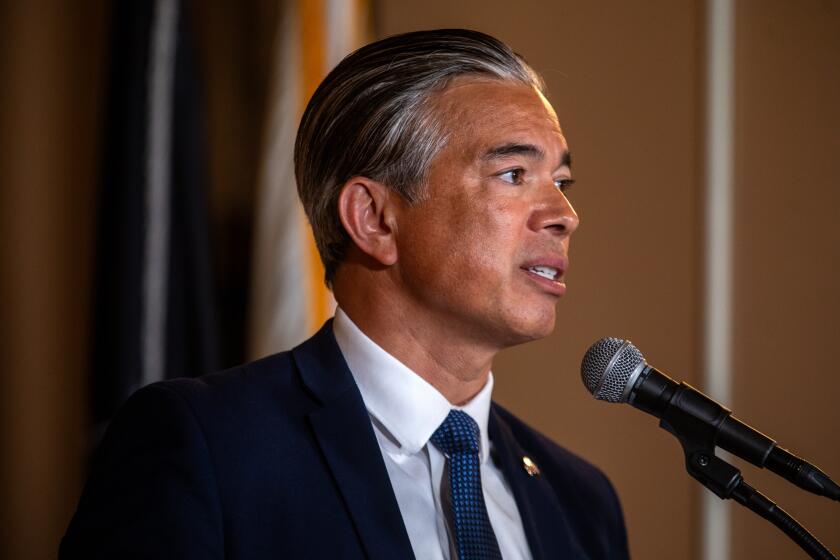Minorities Get GOP Support in Remap Battle : New boundaries: They seek more concentrated districts for greater chances to elect members of their own racial and ethnic groups. Republicans think this would draw from adjacent areas and reduce Democratic power bases.
Blacks, Latinos and Asian-Americans pressing for greater political clout in California are getting strong support from an unusual source: the Republican Party.
As both parties wrestle with the once-a-decade task of redrawing political boundaries, Republicans are talking to people they have long ignored. They found they can advance the cause of minorities while serving their own interests.
The result is an uneasy pairing of old political foes that has some white liberal Democrats on the run.
That is the scenario unfolding in the Capitol as legislators, meeting privately, draft new boundaries for congressional, Assembly and state Senate districts that will take effect for the 1992 elections.
The 1990 Census will give California seven new seats in Congress--the largest gain of any state. With new population figures confirming a shift from the Democratic-dominated cities to the GOP-leaning suburbs, Republicans, who are minorities in both houses of the Legislature, foresee a big opportunity.
The emerging Republican strategy works this way: Ethnic minority groups want their voting power concentrated in districts that will allow them to elect representatives of their choice. If they succeed, adjacent districts would have fewer minority voters--reducing the potential for Democratic victories.
As the line-drawing begins in earnest, at the top of everyone’s agenda--because the law requires it--is how best to bring the number of ethnic minority representatives more into line with their current share of California’s population.
The Democrats, who control the Legislature, are walking a tightrope--trying to accommodate these minority demands without upsetting the status quo. Republicans would like to capitalize on the potential upheaval if they can.
The back-room talks will go public in the next week or so when one Latino group releases a proposed plan and leaders of the Assembly and Senate unveil their maps, which so far have been circulated only privately in bits and pieces. The new districts eventually will be included in legislation that must pass both houses of the Legislature and be signed by the governor to become law. The Legislature could override a governor’s veto with a two-thirds vote of both houses.
Latinos number 7.7 million in California, about 26% of the population. But of the 165 legislative and congressional seats, just 10, or 6%, are filled by Latinos. Asian-Americans make up about 9% of the population but have just two members in Congress and none in the Legislature. Blacks, with 13 representatives in Congress and the Legislature, are the only minority whose numbers in these bodies reflect their population in the state.
The law does not require that districts be drawn to assure the election of more minorities. But the federal Voting Rights Act and recent court interpretations of that law require that where minority populations exist in significant numbers, they be grouped in ways to maximize their influence.
In the past, the Democrats who drew district lines often used minority communities to prolong the careers of white incumbents. They did this by dividing the ethnic communities--which mainly voted Democratic--among several districts to help provide comfortable margins of victory for the incumbents.
A good example is the 16th Senate District, which is built around Bakersfield but jumps the Tehachapi Mountains to grab a mostly black portion of Pasadena. This was done in 1982 to add more Democrats to the district of the late Sen. Walter Stiern. Stiern was reelected, but the district went Republican anyway after he retired.
“The current districts take advantage of blacks,” said Steve Hamilton, a Republican and vice chairman of the Congress of Racial Equality. “You’re nothing more than a pawn. To draw a line down the mountains to encircle only the black community in order to protect a white incumbent 200 miles away--that’s outrageous.”
If such practices were eliminated, minority communities would be split less often, but the seats of Democratic incumbents would not be as secure as they are today. And that is just what the Republicans are hoping for as they seek to take control of the Legislature and the congressional delegation.
“You end up with competitive districts throughout the state,” Benjamin L. Ginsberg, chief counsel for the Republican National Committee, said in an interview. “I think when we get into a fair battle, we’ll do just fine.”
Republicans are putting their theory into practice by drawing maps that begin by addressing the needs of minorities. Republicans in the Legislature reportedly are circulating several such drafts, with Gov. Pete Wilson’s approval, and independent Republican groups are doing the same.
One Bay Area GOP group has drawn a map that creates several more districts than now exist in which Latinos, African-Americans and Asian-Americans would have major influence, if not the ability to elect members of their choice.
Even as minority power is enhanced, 13 of the area’s 36 districts would become winnable for Republicans, in their view. Currently, just six of the region’s seats are in Republican hands.
In Los Angeles, groups representing blacks and Latinos also have drawn plans that maximize their influence, possibly at the expense of white Democrats.
Hamilton’s group, the Congress of Racial Equality, has drawn a plan with the National Assn. for the Advancement of Colored People that preserves the five Assembly, two state Senate and three congressional seats now held by blacks. The maps increase the percentage of blacks in most of these districts by moving the lines one way to shift Latinos into neighboring districts and another to encircle blacks who now are in districts represented by white Democrats.
If these proposed districts were merged with ones being developed by the Mexican-American Legal Defense and Educational Fund (MALDEF), white liberal Democrats on the Westside of Los Angeles would see their districts dramatically changed. It is possible that the boundaries of one of the Westside Assembly seats might be so radically altered and moved that it would go to a Republican instead of a Democrat.
If white Democrats won’t allow their districts to be transformed, the unity professed so far between black and Latino groups might begin to erode. Two Los Angeles Assembly districts now represented by blacks have a majority of residents who are Latinos.
But Arturo Vargas, one of the authors of the MALDEF plan, said he believes that the interests of Latinos can be advanced without diminishing black representation.
“Something is going to have to give,” Vargas said. “The electoral process has been controlled by non-minorities. That is reflected in the makeup of the Legislature and the congressional delegation. We’re trying to rectify that imbalance.”
Vargas said MALDEF envisions eight Los Angeles County Assembly seats in which a majority of voters are Latino, with five of those configured so they would probably elect a Latino to the Legislature’s lower house. Currently, six Assembly districts are dominated by Latinos but only three have elected a Mexican-American.
Vargas said the organization is not concerned about whether such a plan would damage the career of a white incumbent or two. He acknowledged that Republicans are working hard to woo minorities into an alliance, but said his group is keeping the GOP at arm’s length.
“They are pursuing that strategy pretty vigorously,” he said. “They feel they’ve also been given the short end of the stick. . . . We’re not out to protect Democratic seats or Republican seats. Our attitude is we’re going to work with everyone.”
Not all representatives of minorities believe the Legislature must create every minority district possible. Alice Huffman, a close ally of Democratic Assembly Speaker Willie Brown (D-San Francisco) and a representative of the Black American Political Assn., said she believes there are legitimate reasons to leave modest numbers of minorities in several districts, even if it means giving them less of a chance to elect one of their own.
Huffman argues that white lawmakers with some minorities in their districts tend to be more aware of and sensitive to the problems of minorities than they would be otherwise.
If mostly white districts are stripped of all their minorities, she said, “we lose our influence.”
More to Read
Start your day right
Sign up for Essential California for news, features and recommendations from the L.A. Times and beyond in your inbox six days a week.
You may occasionally receive promotional content from the Los Angeles Times.






